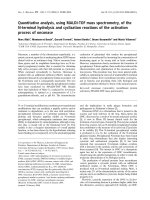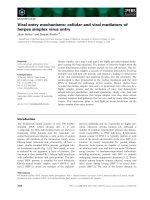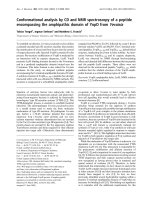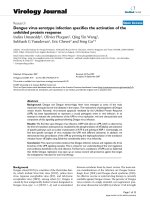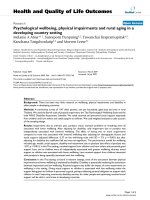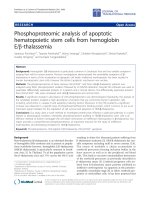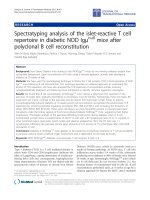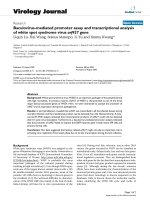Báo cáo sinh học: "Cytogenetic analysis (GTG, CBG and NOR bands) of a wild boar population" pot
Bạn đang xem bản rút gọn của tài liệu. Xem và tải ngay bản đầy đủ của tài liệu tại đây (1.49 MB, 9 trang )
Original
article
Cytogenetic
analysis
(GTG,
CBG
and
NOR
bands)
of
a
wild
boar
population
(Sus
scrofa
scrofa)
with
chromosomal
polymorphism
in
the
south-east
of
Spain
JJ
Arroyo
Nombela
C
Rodriguez
Murcia
1
T
Abaigar
2
JR
Vericad
2
1
Laboratorio
de
Citogenética
Animal
CSIC
c/
Serrano
113,
28006
Madrid;
2
Estacidn
Experimental
de
Zonas
Aridas
CSIC
c/
General
Segura
1,
04001
Almeria,
Spain
(Received
2
January
1989;
accepted
23
September
1989)
Summary -
The
karyotypes
of
12
wild
boars
(4
(J
’,
8 Q )
from
populations
in
Sierra
Nevada
and
Sierra
de
Baza
(Almeria)
were
analysed.
Chromosomal
polymorphism
giving
rise
to
3
variants
in
the
diploid
number
[2n
=
38
(1
(J’),
2n
=
37
(2
(3’,
1
C!!
and
2n
=
36
(1
!!’,
7 Q
)]
was
observed.
By
means
of
GTC-band
analysis,
this
polymorphism
proved
to
be
the
consequence
of
a
Robertsonian
translocation
between
members
of
pairs
15
and
17
of
karyotypes
with
2n
=
38,
thereby
creating
a
long
submetacentric
chromosome
(15/17)
together
with
2
free
acrocentric
chromosomes,
(15
and
17)
in
individuals
with
2n
=
37,
and
a
pair
of
long
submetacentric
chromosomes
(15/17)
in
2n
=
36
specimens.
CBG-band
analysis
revealed
2
types
of
staining
for
heterochromatin:
a
dark
staining,
characteristic
of
acrocentric
chromosomes
and
occasionally
present
in
the
submetacentric
(15/17),
and
a
pale
staining,
characteristic
of
the
rest
of
the
submetacentric
chromosomes.
The
Y-chromosome
presented
dark
heterochromatin
over
the
entire
length
of
its
long
arm.
The
nucleolus
organizers
were
observed
on
pairs
8
and
10
and
showed
heteromorphism
of
the
size
of
the
silver
block
and
in
the
distribution
in
both
pairs.
wild
board
/ karyotype
/ chromosomal
polymorphism
/
nucleolus
organizer
region
/
heterochromatin
Résumé -
Analyse
cytogénétique
(bandes
GTG,
CBG
et
NOR)
d’une
population
de
sangliers
(Sus
scrofa
scrofa)
et
de
son
polymorphisme
dans
le
Sud-Est
de
l’Espagne
-
Les
caryotypes
de
12
sangliers (4
mâles
et
8
femelles)
provenant
de
la
Sierra
Nevada
et
Sierra
de
Baza
(Almeria)
ont
été
analysés.
Un
polymorphisme
chromosomique
a
été
observé
donnant
3
variantes
en
ce
qui
concerne
le
nombre
diploïde
de
chromosomes:
2n
=
38 (1
mâle);
2n
=
37 (2
mâles,
1
femelle),
2n
=
36
(1
mâle,
7
femelles).
En
utilisant
les
bandes
GTG
on
a
montré
que
le
polymorphisme
est
la
conséquence
d’une
translocation
robertsonnienne
entre
les
représentants
des
paires
15
et
17
des
caryotypes
ayant
2n
=
38;
créant
ainsi
un
long
submétacentrique
(15/17)
avec
en
même
temps
2
acrocentriques
isolés,
15
et
17,
chez
les
individus
2n
=
36.
Une
analyse
à
l’aide
*
Correspondence
and
reprints
des
bandes
CBG
a
montré
2 sortes
de
coloration
pour
l’hétérochromatine:
une
col-
oration
sombre
caractéristique
des
chromosomes
acrocentrique
et
parfois
présente
dans
les
submétacentriques
(15/17),
et
une
coloration
claire
caractéristique
des
autres
chromo-
somes
submétacentriques.
Le
chromosome
Y
présente
de
l’hétérochromatine
sombre
sur
toute
la
longueur
de
ses
6ras.
Les
organisateurs
nucléolnires
ont
été
observés
sur
les
paires
8
et
10
et
ont
montré
une
différence
dans
la
taille
des
paquets
d’argent
et
dans
leur
dis-
tribution
au
niveau
de
2
paires.
sanglier
/
caryotype
/
polymorphisme
chromosomique
/
organisateur
nucléolaire
/
hétérochromatine
INTRODUCTION
In
spite
of
the
abundance and
importance
of
wild
boars
in
the
peninsular
regions
of
Spain,
little
is
known
about
the
chromosomal
make-up
of
these
animals.
This
lack
of
karyological
data
has
motivated
our
cytogenetic
studies
of
this
South-West
European
population
of
wild
boars.
In
addition,
this
research
supplements
similar
studies
of wild
boar
populations
in
other
European
regions,
such
as
Germany
(McFee
et
al,
1966;
Gropp
et
al
1969),
Yugoslavia
(Zivkovic
et
al,
1971),
the
Netherlands
(Bosma,
1976),
Sweden
(Gustavsson
et
al,
1973),
France
(Mauget
et
al,
1977;
Popescu
et
al,
1980),
Switzerland
(Jotterand-Bellomo
and
Baettig,
1981),
Austria
(Rittmannsberger,
1971;
Mayr
et
al 1984),
and
Russia
(Tikhonov
and
Troshina,
1975;
Troshina
and
Tikhonov,
1980).
MATERIAL
AND
METHODS
The
study
comprised
12
specimens
(4
d
’ ,
8 Q )
of
a
Sus
scrofa scrofa
population,
all
native
to
Sierra
Nevada
and
Sierra
de
Baza
(Almeria,
Spain).
The
karyotype
was
obtained
from
whole
blood
cultures.
Blood
samples
were
taken
by
venous
puncture
from
anaesthesized
males
(n
=
4)
and
by
means
of
cardiac
puncture
in
the
females
(n
=
8).
The
cultures
consisted
of
0.4
ml
blood
in
7.5
ml
RPMI-1640
medium
supplemented
with
15%
fetal
bovine
serum;
L-glutamin,
antibiotics
and
phytohaemaglutinin.
The
preparations
were
analysed
by
the
following
banding
techniques:
GTG
(Seabright,
1972),
CBG
(Sumner,
1972)
and
silver
nitrate
staining,
NOR
S,
(Bloom
and
Goodpasture,
1976).
Using
the
same
methodology,
we
analysed
the
chromo-
somes
of
4
hybrids
from
a
male
wild
boar
and
a
domestic
sow.
RESULTS
Chromosome
analysis
carried
out
with
conventional
Giemsa
staining
enabled
us
to
verify
the
existence
of
numerical
variability
in
the
chromosomal
sets
among
the
animals
analysed.
Among
the
12
animals
analysed,
1
of
the
males
possessed
2n
=
38,
2
males
and
1
female
were
2n
=
37,
and
7
females
and
1
male
were
2n
=
36.
This
numeric
variability
was
correlated
with
a
morphological
variability
in
2
chromosomal
paires.
However,
no
phenotypical
variability
was
observed.
Application
of
different
banding
techniques
allowed
us
to
analyse
the
cytogenetic
mechanisms
involved
in
the
numerical
and
structural
variability
encountered
in
the
3
variants
described
above.
GTG
bands
The
metaphases
treated
with
proteolytic
enzymes
(GTG
bands)
showed
that
the
karyotype
of
the
male
wild
boar
with
2n
=
38
(Fig
1)
consisted
of
5
submetacentric
chromosomal
pairs
(1-5),
2
subacrocentric
pairs
(6-7),
5
metacentric
pairs
(8-12)
and
6
acrocentric
pairs
(13-18),
plus
the
2
gonosomes
(metacentric
X-chromosome,
of
similar
length
to
the
autosomal
pair
9,
and
a
small
metacentric
Y).
This
karyotype
is
identical
(in
number
of
chromosomes,
morphology
and
banding
patterns)
to
the
karyotype
of
the
domestic
pig
(Halgeltorn
and
Gustavsson,
1973;
Lin
et
al,
1980).
The
metaphases
with
2n
=
37
(Fig
2)
presented
structural
heteromorphism
in
pairs
15
and
17,
resulting
in
2
unpaired
acrocentric
chromosomes
(see
arrows
in
Fig
2)
and
a
long
submetacentric
chromosome
(15/17)
with
a
length
intermediate
between
pairs
1
and
2.
The
p
and
q arms
of
this
submecentric
chromosome
had
banding
patterns
and
relative
length
identical
to
the
2
acrocentric
chromosomes
15
and
17.
The
other
pairs,
including
the
gonosomes,
were
identical
to
those
of
the
individuals,
with
2n
=
38.
A
Robertsonian
translocation
(centric
fusion)
between
1
chromosome,
each
of
pairs
15
and
17,
would
account
for
the
heteromorphism
found
in
the
2n
=
37
specimens,
and
hence,
explain
the
numerical
variation
in
the
diploid
chromosome
number.
Finally,
the
metaphases
with, 2n
=
36
(Fig
3)
lacked
the
unpaired
acrocentrics
(15
and
17)
characteristic
of
2n
=
37,
but
contained
a
pair
of
long
submetacentric
(15/17)
chromosomes.
CBG
bands
CBG-band
analysis
(Summer,
1972),
revealed
2
types
of
centromeric
heterochro-
matin
in
the
karyotypes:
a
darker
staining
which
proved
to
be
alkali
resistant
and
very
constant
and
which
was
found
in
all
acrocentric
chromosomes,
and
a
pale,
alkali-labile
staining
associated
with
the
subtelocentric
and
meta-submetacentric
chromosomes.
The
heterochromatin
blocks
of
the
acrocentric
chromosomes
varied
in
size,
even
for
chromosomes
of
the
same
pair,
but
were
observed
for
all
chromosomes
of
this
morphological
class.
In
contrast,
the
heterochromatin
of
non-acrocentric
pairs
was
pale
(at
times
not
even
detectable)
and
showed
a
graded
staining
pat-
tern
according
to
the
pairs,
but
was
particularly
constant
in
pair
1.
The
(15/17)
chromosome
was
exceptional
in
having
a
double
block
of
dark-staining
centromeric
similar
to
that of
the
unpaired
acrocentric
chromosomes
15
and
17
(Figs
4
and
5).
Frequently,
a
kind
of
intercalary
heterochromatin
was
detected
in
the
long
arm
of
pair
10
in
the
proximity
of
the
secondary
constriction,
which
correspond
to
the
nucleolus
organizer
of
this
pair.
The
long
arm
of
the
Y-chromosome
was
totally
The
X-chromosome,
however,
usually
lacked
the
heterochromatin
staining,
or
was
very
pale
and
could
not
be
differentiated
from
the
heterochromatin
of
the
autosomal
pairs
of
similar
length
and
morphology
(pairs
8
and
9).
NOR
bands
The
nucleolus
organizer
regions,
detected
by
means
of
silver
staining
(Bloom
and
Goodpasture,
1976)
are
located
in
the
paracentrometric
region
of
the
short
arm
of
pair
8
and
the
long
arm
of
pair
10
(Fig
6).
Polymorphism,
both
in
the
size
of
the
silver
blocks
and
in
the
distribution
within the
pair,
was
observed.
Block
size
was
larger
in
the
chromosomes
of
pair
10,
and
even
within
this
pair
there
existed
size
variability
of
the
block
in
the
homologous
chromosomes.
Analysis
of
nucleolus
organizer
distribution
on
347
metaphases
of
4
animals
(2
C3’,
2
!)
is
summarized
in
Table
I.
Table
I
shows
that
84%
of
the
metaphases
contained
some
active
nucleolus
or-
ganizer
regions.
Of
these,
80%
were
from
metaphases
with
at
least
1
active
chro-
mosome
in
pair
10,
while
72%
of
metaphases
showed
staining
in
both
chromosome
of
pair
10.
Only
4%
presented
staining
in
a
chromosome
of
pair
8,
and
only
1.15%
of
the
metaphases
showed
4
active
chromosome.
In
addition,
chromosomal
associations
were
observed
in
pair
10,
giving
rise
to
tetraradial
structures
(Fig
6b),
a
phenomenon
which
was
not
recorded
for
pair
8,
or
between
pairs
8
and
10.
DISCUSSION
This
study
provides
evidence
that
Spanish
wild
boars
present
cytogenetic
charac-
teristics
which
show
a
high
degree
of
similarity
to
those
of
other
European
popula-
tions
(McFee
et
al,
1966;
Gropp
et
al,
1969;
Zivkovic
et
al,
1971;
Gustavsson
et
al,
1973;
Bosma,
1976,
Mauget
et
al,
1977;
Popescu
et
al,
1980;
Jotterand-Bellomo
and
Baettig,
1981;
Mayr
et
al,
1984).
In
fact,
the
wild
boar
and
domestic
pig
karyotypes
are
very
similar.
In
specimens
with
2n
=
38,
it
proved
to
be
impossible
cytogenetically
to
differentiate
between
subspecies,
as
they
showed
identical
features
in
the
number
of
chromosomes,
pair
morphology
and
even
banding
patterns
for
both
gonosomes
and
autosomes.
In
addition,
the
Spanish
wild
boar
population
presents
a
numerical
polymorphism
with
3
variants
in
their
chromosomal
sets
(2n
=
36,
37
and
38)
as
a
consequence
of
a
translocation
involving
pairs
15
and
17.
A
similar
polymorphism
has
also
been
observed
in
German
wild
boar
populations
studied
by
McFee
et
al
(1986),
in
the
Dutch
specimens
(Bosma,
1976),
as
well
as
in
the
Austrian
population
reported
by
Mayr
et
al,
(1984).
However,
the
German
specimens
analysed
by
Gropp
et
al
(1969)
as
well
as
the
French
studies
(Mauget
et
al,
1977;
Popescu
et
al,
1980)
and
the
Swiss
population
(Jotterand-Bellomo
and
Beattig,
1981),
did
not
present
this
polymorphism
and
are
homogenous
populations
with
2n
=
36.
Finally,
Zivkovic
et
al
(1971)
discovered
2n
=
38
sets
in
certain
specimens
native
to
different
regions
in
Yugoslavia,
and
Popescu
et
al,
(1980)
in
animals
from
the
island
of
Corsica.
These
studies
confirm
the
variability
in
the
wild
boar
karyotype
which
contrasts
with
the
constancy
found
for
domestic
pig
karyotype,
independent
of
origin
(Hansen,
1972;
Gustavsson
et
al,
1972;
Berger,
1972;
Hageltorn
and
Gustavsson,
1973;
Hansen-
Melander
and
Melander,
1974;
Ford
et
al,
1980;
Lin
et
al,
1980;
Ronne
et
al,
1987).
In
the
light
of
the
analogies
between
the
wild
boar
and
domestic
pig
karyotypes
differentiated
only
by
a
Robertsonian
translocation,
one
can
only
speculate
about
the
ancestral
karyotype
of
these
species.
Are
the
15
and
17
acrocentric
chromo-
somes,
or
the
15/17
submetacentric
chromosomes
the
ancestral
morphology?
The
involvement
of
chromosome
17
in
2
Robertsonian
translocations
[(15/17)
in
the
European
wild
boar
and
(16/17)
in
the
Asian
species
(Tikhonov
and
Troshina,
1975)]
suggests
fusion
as
the
most
likely
process
during
evolution,
and
hence,
the
ancestral
karyotype
most
likely
contained
the
acrocentric
chromosomes.
On
the
other
hand,
the
centrometric
heterochromatin
of
the
submetacentric
pair
15/17,
unlike
the
other
meta-submetacentric
chromosomes,
showed
dark
staining
similar
to
acrocentric
chromosomes.
This
exception,
in
turn,
allows
for
speculation
about
the
ancestral
character
of
the
acrocentric
chromosomes.
It
is
legitimate
to
assume
the
dark
heterochromatin
to
be
ancestral
heterochromatin
and
the
pale
heterochro-
matin
to
be
a
derivative
of
the
former.
This
assumption
is
indirectly
supported
by
evidence
provided
by
Arroyo
Nombela
and
Rodriguez
Murcia
(1977),
who
reported
a
spontaneous
double
Robertsonian
translocation
which
appeared
in
a
colony
of
NMRI
mice,
showing
that
the
resulting
biarmed
chromosomes
(2,3)
and
(X,3)
had
dark-stained
double
heterochromatin
block
and
even
retained
the
relative
lengths
of
the
acrocentric
chromosome
blocks
from
which
they
had
originated.
Hence,
the
translocation
does
not
alter
the
nature
of
the
heterochromatin.
Moreover,
its
differentiation
would
occur
at
a
later
stage
as
a
gradual
adaptive
process
of
the
rearrangement
in
the
population
extending
over
a
long
period
of
time.
Both
kinds
of
heterochromatin
are
generalized
in
the
karyotype
of
mammals
with
acrocentric
and
metacentric
chromosomes.
Furthermore,
we
also
found
this
occurring
in
Gazella
dama
mhorr
(unpublished
data)
with
graded
staining
in
the
different
meta-submetacentric
data
pairs.
This
grading
could
be
taken
as
an
indicator
of
the
rearrangement
chronology.
Furthermore,
we
suggest
that
the
ancestral
karyotype
with
2n
=
38
gave
rise
to
European
wild
boar
species
by
means
of
a
15/17
Robertsonian
translocation,
and
to
the
Asian
wild
boar
variety
by
means
of
another
16/17
translocation.
The
Robertsonian
translocations
differentiating
the
domestic
pig
and
the
wild
boar
karyotypes
do
not
inhibit
hybridization
of
the
subspecies.
We
have
examined
a
litter
of
4
young
wild
boars
which
resulted
from
the
breeding
of
a
male
wild
boar
and
a
domestic
sow.
The
descendants
showed
sets
of
2n
=
38
and
37.
In
this
context,
the
work
of
Troshina
and
Tikhonov
(1980)
on
Landrace
pig
and and
European
wild
boar
(15/17),
as
well
as
Asian
wild
boar
(16/17)
hybrids,
is
highly
conclusive,
demonstrating
that
neither
of
the
2
translocations
constitute
an
isolating
reproductive
barrier,
and
that
viable
and
fertile
hybrids
were
obtained
from
crosses
of these
subspecies,
resulting
in
2n
=
36
(34
+
15/17
+
16/17).
In
this
light,
it
seems
legitimate
to
consider
Sus
scrofa
domestica,
Sus
scrofa
scrofa
and
Sus
scrofa
nigri
P
ens
as
3
karyotypic
races.
It
is
not
clear
whether
the
present
numerical
polymorphism
observed
is
due
to
a
recent
translocation
or
to
interbreeding
of
domestic
pig
and
wild
boar.
The
size
and
general
presence
of
the
silver
blocks
on
the
pair
10
in
all
analysed
individuals
cause
us
to
think
that
this
pair
must
be
considered
as
the
main
site
of
r-RNA
production.
No
phenotypic
variability
was
observed
in
any
of
the
analysed
specimens,
which
have
the
appearance
of
true
typical
wild
boars.
Usually
Robertsonian
polymorphisms
have
no
phenotypic
expression.
ACKNOWLEDGMENTS
We
are
grateful
to
Mr
A
Rueda
and
Mr
J
Vallejo
for
generous
assistance
in
the
field.
REFERENCES
Arroyo
Nombela
JJ,
Rodriguez
Murcia
C
(1977)
Spontaneous
double
Robertsonian
translocation
Rb
(2.3)
and
Rb
(X.3)
in
the
mouse.
Cytogenet
Cell
Genet
19,
227-230
Berger
R
(1972)
Etude
du
caryotype
du
porc
avec
une
nouvelle
technique.
Exp
Cell
Res
75, 298-300
Bloom
SE,
Goodpasture
C
(1976)
An
improved
technique
for
selective
silver
staining
of
nucleolar
organizer
regions
in
human
chromosomes.
Hum
Genet
34,
199-206
Bosma
AA
(1976)
Chromosomal
polymorphism
and
G-banding
patterns
in
the
wild
boars
(Sus
scrofa
L)
from
the
Netherlands.
Genetica
46, 391-399
Ford
CE,
Pollock
DL,
Gustavsson
I
(1980)
Proc
1st
Int
Conf for
the
Standardization
of Banded
Karyotywe
of Domestic
Animals.
Hereditas
91,
142-162
Gropp
A,
Giers
D,
Tettenborn
U
(1969)
Das
Chromosomenkomplement
des
Wild-
schweins
(Sus
scrofa).
Experientia
25,
778
Gustavsson
I,
Hageltorn
J,
Johanson
C,
Zech
L
(1972)
Identification
of
the
pig
chromosomes
by
the
quinacrine
mustard
fluorescent
technique.
Exp
Cell
Res
70,
471-474
Gustavsson
I,
Hagelthorn
M,
Zech
L,
Reiland
S
(1973)
Identification
of
the
chromosomes
in
centric
fusion,
fission
polymorphic
system
of
the
pig
(Sus
scrofa
L)
Hereditas
75,
153-155
Hagelthorn
M,
Gustavsson
I
(1973)
Giemsa
staining
patterns
for
identification
of
the
pig
mitotic
chromosomes.
Hereditas
75,
144-146
Hansen
KM
(1972)
The
karyotype
of
the
pig
(Sus
scrofa
domestica)
identified
by
quinacrine
mustard
staining
and
fluorescent
microscopy.
Cytogenetics
11,
286-294
Hansen-Melander
E,
Melander
Y
(1974)
The
karyotype
of
the
pig.
Hereditas
77,
149-158
Jotterand-Bellomo
M,
Baettig
M
(1981)
Etude
cytog6n6tique
de
deux
sangliers
(Sus
scrofa)
de
couleur
claire
captures
aux
environs
de
Geneve
(Suisse).
Rev
Suisse
Zool
88,
787-795
Lin
CC,
Biederman
BM,
Jamro
HK,
Hawthorne
AB,
Church
RB
(1980)
Porcine
(Sus
scrofa
domestica)
chromosome
identification
and
suggested
nomenclature.
Can
J
Genet
Cytol 22,
103-116
Mauget
R,
Castet
MC,
Maraud
R,
Canivenc
R
(1977)
Etude
dynamique
et
caryotypique
d’une
population
de
sangliers
a
robe
claire.
CR
Seanc
Soc
Biol
171,
592-596
Mayr
B,
Schweizer
D,
Geber
G
(1984)
NOR
activity
heterochromatin
differentiation
and
the
Robertsonian
polymorphism
in
Sus
scrofa
L.
J
Hered
75,
79-80
McFee
AF,
Banner
MW,
Rary
JM
(1966)
Variation
in
chromosome
number
among
European
wild
pigs.
Cytogenetics
5,
75-81
Popescu
CP,
Quere
JP,
Francesci
P
(1980)
Observations
chromosomiques
chez
le
sanglier
fran!ais
(Sus
scrofa
scrofa).
Ann
Gen6t
Sel
Anim
12,
395-400
Rittmannsberger
C
(1971)
Chromosomenuntersuchungen
bei
Wild
und
Hauss-
chweinen.
Ann
Genet
Sel
Anim
3,
105-107
Ronne
M,
Stefanova
V,
Di
Berardino
D,
Strandby
Poulsen
B
(1987)
The
R-banded
karyotype
of
the
domestic
pig.
Sus
scrofa
domestica
L.
Hereditas
106,
219-231
Seabright
M
(1972)
The
use
of
proteolytic
enzymes
for
mapping
of
structural
rearrangement
in
the
chromosomes
of
man.
Chromosoma
36,
204-210
Sumner
AT
(1972)
A
simple
technique
for
demonstrating
centrometric
heterochro-
matin. Exp
Cel
Res
75,
304-306
Tikhonov
VN,
Troshina
AI
(1975)
Chromosomes
translocations
in
the
karyotypes
of
wild
boars.
Sus
scrofa
L
of
the
European
and
the
Asian
Areas
of
USSR.
Theor
Appl
Genet 45,
304-308
Troshina
AI,
Tikhonov
VN
(1980)
The
reproductive
features
of
Landrace
x
wild
boar
hybrid
with
two
chromosomal
translocation
Tr
1
(16/17)
Tr
2
(15/17).
4th
Eur
Colloq
Citogenet
Domest
Anim,
pp
250-261
Zivkovic
S,
Jovanovic
V,
Isakovic
I,
Milosevic
M,
(1971)
Chromosome
complement
of
the
European
wild
pig.
(Sus
scrofa
L)
Experientia
27,
224-226
